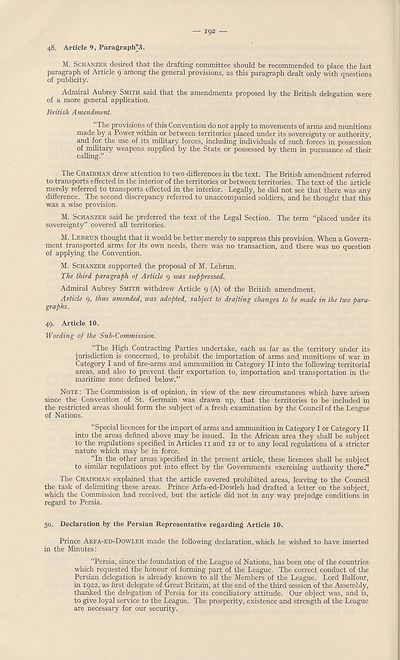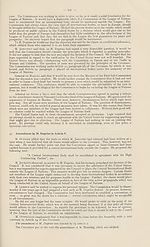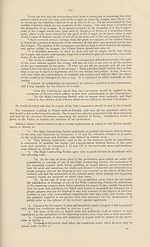Armament > Conference for the control of the international trade in arms, munitions and implements of war
(194)
Download files
Complete book:
Individual page:
Thumbnail gallery: Grid view | List view

— 192 —
48. Article 9, Paragraph^.
M. Schanzer desired that the drafting committee should be recommended to place the last
paragraph of Article g among the general provisions, as this paragraph dealt only with questions
of publicity.
Admiral Aubrey Smith said that the amendments proposed by the British delegation were
of a more general application.
British Amendment.
The provisions of this Convention do not apply to movements of arms and munitions
made by a Power within or between territories placed under its sovereignty or authority,
and for the use of its military forces, including individuals of such forces in possession
of military weapons supplied by the State or possessed by them in pursuance of their
calling.”
The Chairman drew attention to two differences in the text. The British amendment referred
to transports effected in the interior of the territories or between territories. The text of the article
merely referred to transports effected in the interior. Legally, he did not see that there was any
difference. The second discrepancy referred to unaccompanied soldiers, and he thought that this
was a wise provision.
M. Schanzer said he preferred the text of the Legal Section. The term “placed under its
sovereignty” covered all territories.
M. Lebrun thought that it would be better merely to suppress this provision. When a Govern¬
ment transported arms for its own needs, there was no transaction, and there was no question
of applying the Convention.
M. Schanzer supported the proposal of M. Lebrun.
The third paragraph of Article g was suppressed.
Admiral Aubrey Smith withdrew Article g (A) of the British amendment.
Article g, thus amended, was adopted, subject to drafting changes to be made in the two para¬
graphs.
49. Article 10.
Wording of the Sub-Commission.
“The High Contracting Parties undertake, each as far as the territory under its
jurisdiction is concerned, to prohibit the importation of arms and munitions of war in
Category I and of fire-arms and ammunition in Category II into the following territorial
areas, and also to prevent their exportation to, importation and transportation in the
maritime zone defined below.”
Note: The Commission is of opinion, in view of the new circumstances which have arisen
since the Convention of St. Germain was drawn up, that the territories to be included in
the restricted areas should form the subject of a fresh examination by the Council of the League
of Nations.
“Special licences for the import of arms and ammunition in Category I or Category II
into the areas defined above may be issued. In the African area they shall be subject
to the regulations specified in Articles 11 and 12 or to any local regulations of a stricter
nature which may be in force.
“In the other areas specified in the present article, these licences shall be subject
to similar regulations put into effect by the Governments exercising authority there.”
The Chairman explained that the article covered prohibited areas, leaving to the Council
the task of delimiting these areas. Prince Arfa-ed-Dowleh had drafted a letter on the subject,
which the Commission had received, but the article did not in any way prejudge conditions in
regard to Persia.
50. Declaration by the Persian Representative regarding Article 10.
Prince Arfa-ed-Dowleh made the following declaration, which he wished to have inserted
in the Minutes:
“Persia, since the foundation of the League of Nations, has been one of the countries
which requested the honour of forming part of the League. The correct conduct of the
Persian delegation is already known to all the Members of the League. Lord Balfour,
in 1922, as first delegate of Great Britain, at the end of the third session of the Assembly,
thanked the delegation of Persia for its conciliatory attitude. Our object was, and is,
to give loyal service to the League. The prosperity, existence and strength of the League
are necessary for our security.
48. Article 9, Paragraph^.
M. Schanzer desired that the drafting committee should be recommended to place the last
paragraph of Article g among the general provisions, as this paragraph dealt only with questions
of publicity.
Admiral Aubrey Smith said that the amendments proposed by the British delegation were
of a more general application.
British Amendment.
The provisions of this Convention do not apply to movements of arms and munitions
made by a Power within or between territories placed under its sovereignty or authority,
and for the use of its military forces, including individuals of such forces in possession
of military weapons supplied by the State or possessed by them in pursuance of their
calling.”
The Chairman drew attention to two differences in the text. The British amendment referred
to transports effected in the interior of the territories or between territories. The text of the article
merely referred to transports effected in the interior. Legally, he did not see that there was any
difference. The second discrepancy referred to unaccompanied soldiers, and he thought that this
was a wise provision.
M. Schanzer said he preferred the text of the Legal Section. The term “placed under its
sovereignty” covered all territories.
M. Lebrun thought that it would be better merely to suppress this provision. When a Govern¬
ment transported arms for its own needs, there was no transaction, and there was no question
of applying the Convention.
M. Schanzer supported the proposal of M. Lebrun.
The third paragraph of Article g was suppressed.
Admiral Aubrey Smith withdrew Article g (A) of the British amendment.
Article g, thus amended, was adopted, subject to drafting changes to be made in the two para¬
graphs.
49. Article 10.
Wording of the Sub-Commission.
“The High Contracting Parties undertake, each as far as the territory under its
jurisdiction is concerned, to prohibit the importation of arms and munitions of war in
Category I and of fire-arms and ammunition in Category II into the following territorial
areas, and also to prevent their exportation to, importation and transportation in the
maritime zone defined below.”
Note: The Commission is of opinion, in view of the new circumstances which have arisen
since the Convention of St. Germain was drawn up, that the territories to be included in
the restricted areas should form the subject of a fresh examination by the Council of the League
of Nations.
“Special licences for the import of arms and ammunition in Category I or Category II
into the areas defined above may be issued. In the African area they shall be subject
to the regulations specified in Articles 11 and 12 or to any local regulations of a stricter
nature which may be in force.
“In the other areas specified in the present article, these licences shall be subject
to similar regulations put into effect by the Governments exercising authority there.”
The Chairman explained that the article covered prohibited areas, leaving to the Council
the task of delimiting these areas. Prince Arfa-ed-Dowleh had drafted a letter on the subject,
which the Commission had received, but the article did not in any way prejudge conditions in
regard to Persia.
50. Declaration by the Persian Representative regarding Article 10.
Prince Arfa-ed-Dowleh made the following declaration, which he wished to have inserted
in the Minutes:
“Persia, since the foundation of the League of Nations, has been one of the countries
which requested the honour of forming part of the League. The correct conduct of the
Persian delegation is already known to all the Members of the League. Lord Balfour,
in 1922, as first delegate of Great Britain, at the end of the third session of the Assembly,
thanked the delegation of Persia for its conciliatory attitude. Our object was, and is,
to give loyal service to the League. The prosperity, existence and strength of the League
are necessary for our security.
Set display mode to:
![]() Universal Viewer |
Universal Viewer | ![]() Mirador |
Large image | Transcription
Mirador |
Large image | Transcription
Images and transcriptions on this page, including medium image downloads, may be used under the Creative Commons Attribution 4.0 International Licence unless otherwise stated. ![]()
| League of Nations > Armament > Conference for the control of the international trade in arms, munitions and implements of war > (194) |
|---|
| Permanent URL | https://digital.nls.uk/195384285 |
|---|
| Shelfmark | LN.IX |
|---|
| Description | Over 1,200 documents from the non-political organs of the League of Nations that dealt with health, disarmament, economic and financial matters for the duration of the League (1919-1945). Also online are statistical bulletins, essential facts, and an overview of the League by the first Secretary General, Sir Eric Drummond. These items are part of the Official Publications collection at the National Library of Scotland. |
|---|---|
| Additional NLS resources: |
|

